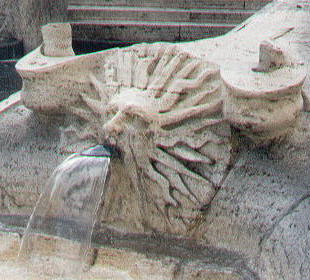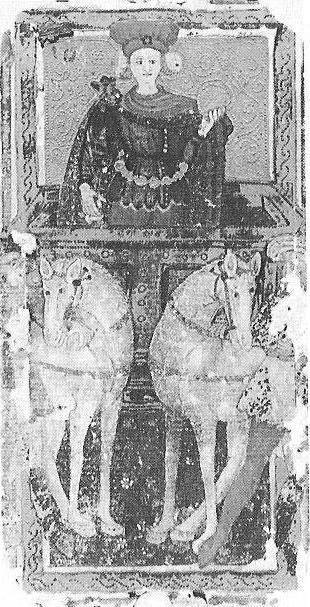Huck
As surviving card decks with some Florence dominance we may count:
* Rothschild cards (more or less without trumps)
http://trionfi.com/0/c/40/
* Charles VI deck (16 trumps)
http://expositions.bnf.fr/renais/arret/3/index.htm
* Ursino cards - partly same motifs as Charles VI (4 trumps, one very unusual)
http://trionfi.com/0/j/d/charlesvi/
* Rosenwald deck (21 trumps; same halo's as Charles VI)
http://trionfi.com/0/j/d/rosenwald/
The Rosenwald deck might be considered as close to the Bologna pattern.
http://trionfi.com/0/j/d/bologna/
So it might be well to have a look at the historical connections between Bologna and Florence.
In 1445, after Bologna stood some time under the dominance of Filippo Maria Visconti and Milan, the Bentivoglio tried to get the power again. It did lead to a massacre, in which nearly all Bentivoglio died (beside the young Giovanni Bentivoglio), the massacre itself did lead to a counter-massacre of the Bolognese population on the murder families. In this situation the Bolognese population had the desire to reinstall the Bentivoglio rule - but there was no Bentivoglio in the right age reachable. They found, that a distant relative of the Bentivoglio still lived and worked in humble position in Florence. They invited him to rule in Bologna and to get the Bentivoglio possessions, a somehow very curious act. The relative in Florence hesitated (living as a Bentivoglio was obviously dangerous), but talked with Cosimo de Medici, who gave the advice to accept the offer.
http://en.wikipedia.org/wiki/Bentivoglio
http://en.wikipedia.org/wiki/Giovanni_II_Bentivoglio
Since then we might assume, that the relations between Bologna and Florence had been mostly rather friendly if not really good till the end of 15th century.
Lorenzo was a guest at the 1487 Bentivoglio marriage Lucrezia d'Este - Annibale Bentivoglio and a year later Lorenzo engaged successful with diplomatical ways to get the ruler Giovanni Bentivoglio out of serious difficulties.
Generally: The distance between Florence and Bologna is not too far (maybe 110 km in old time), and the landroute between the both cities is not disturbed by other major cities influences. They are neighbours, although the way to each other is difficult by a mountain region (one has to cross ca. 900 m). But - this way should have been a major traffic route for a quick connection between Northern and Southern part of Italy.
It should have been the major land route to Rome also.
******
There is one specific interesting information about this "Sante of Florence", who became a Bentivoglio in Bologna: He worked in the wool industry. This is interesting in combination with the following info:
http://books.google.com/books?id=-a...j-Bg&sig=lXYYdn0Fs-TInZ7H4UV68ndHEt4#PPA75,M1
From Florence we know, that it's major income for the wealth of the city was not the banking, but the textil industry, and the above mentioned document shows, that the near Bologna tried to participate in the same business.
For Tarot history the question is of interest, cause we find on the sun card of the Charles VI deck and at sun cards in (likely following) decks of Bologna
a female, which uses the wool-spindle (the motif reappears in decks in 16th, 17th and 18th century clearly given to Bologna, presented in Andrea Vitali's Tarocchi Bolognese; also shown in Kaplan I p. 128)


see more
http://trionfi.com/0/j/d/bologna/
We don't find this motif in Ferrara nor Milan. Interestingly we also don't find
it in the Rosenwald Tarot, which is suggested (recently by Ross) to belong to Florence (which used a sun, which appeared probably in 1470 at the church of Santa Maria Novella (Alberti design)).


see more of the deck at
http://trionfi.com/0/j/d/rosenwald/
see some argumentation to this in post 80, Christina Fiorini-thread
http://tarotforum.net/showthread.php?t=90846&page=8&pp=10
Considering this idea, there is the strange appearance, that the Barberini family of Florence, which had around 1470 a humble state, at begin of 17th century became a pope-family and that in the heraldic of this family a sun was used

see more
http://romeartlover.tripod.com/sole.html
(?) possibly an adaption of the San Maria Novella sun (?), as the general (and perhaps original) family heraldic seems to have been 3 bees.
... though the Barberini sun has some more lines to the outside
*******
The Rosenwald Tarocchi offers a funny sequence of the cards with some additional confusion by the painter. Now the short article in Kaplan explains, that the Deutsches Spielkartenmuseum Stuttgart-Rheinfelen possesses the "right order" - without saying, what the right order is at this sheet.
Kaplan I. p. 130 - 131
compare also:
If one takes the sheet just in the row, as it is, one finds, that the row is almost near to "strange" orders in poems, which Andrea Vitali offers in his "il Tarocchino di Bologna" (2005)
With one exception: The chariot has at the Rosenwald the number 10, and the Wheel should have number 13 ... if one follows the row.
Now it is so, that the Ursino card "Chariot" (the cards with nearness to the Charles VI cards) also has a small 10 (difficult to see at first view) in the left upper corner

... which somehow leads to the opinion, that this might be the old Florentine order or a part of it.
Another 10 on a chariot we've at the Colonna cards ... Kaplan p. 134; in this case the wheel of Fortune has recognizable the number 11.
This is deck of Rome; Rome might have been naturally influenced by the Florencian style of Tarot cards.
* Rothschild cards (more or less without trumps)
http://trionfi.com/0/c/40/
* Charles VI deck (16 trumps)
http://expositions.bnf.fr/renais/arret/3/index.htm
* Ursino cards - partly same motifs as Charles VI (4 trumps, one very unusual)
http://trionfi.com/0/j/d/charlesvi/
* Rosenwald deck (21 trumps; same halo's as Charles VI)
http://trionfi.com/0/j/d/rosenwald/
The Rosenwald deck might be considered as close to the Bologna pattern.
http://trionfi.com/0/j/d/bologna/
So it might be well to have a look at the historical connections between Bologna and Florence.
In 1445, after Bologna stood some time under the dominance of Filippo Maria Visconti and Milan, the Bentivoglio tried to get the power again. It did lead to a massacre, in which nearly all Bentivoglio died (beside the young Giovanni Bentivoglio), the massacre itself did lead to a counter-massacre of the Bolognese population on the murder families. In this situation the Bolognese population had the desire to reinstall the Bentivoglio rule - but there was no Bentivoglio in the right age reachable. They found, that a distant relative of the Bentivoglio still lived and worked in humble position in Florence. They invited him to rule in Bologna and to get the Bentivoglio possessions, a somehow very curious act. The relative in Florence hesitated (living as a Bentivoglio was obviously dangerous), but talked with Cosimo de Medici, who gave the advice to accept the offer.
Macchiavelli: "... having been murdered by the Canneschi, who had conspired against him, not one of his family survived but Messer Giovanni, who was in childhood: immediately after his assassination the people rose and murdered all the Canneschi. This sprung from the popular goodwill which the house of Bentivoglio enjoyed in those days in Bologna; which was so great that, although none remained there after the death of Annibale who were able to rule the state, the Bolognese, having information that there was one of the Bentivoglio family in Florence, who up to that time had been considered the son of a blacksmith [Sante], sent to Florence for him and gave him the government of their city, and it was ruled by him until Messer Giovanni came in due course to the government." (The Prince, Chapter XIX)
http://en.wikipedia.org/wiki/Bentivoglio
http://en.wikipedia.org/wiki/Giovanni_II_Bentivoglio
Since then we might assume, that the relations between Bologna and Florence had been mostly rather friendly if not really good till the end of 15th century.
Lorenzo was a guest at the 1487 Bentivoglio marriage Lucrezia d'Este - Annibale Bentivoglio and a year later Lorenzo engaged successful with diplomatical ways to get the ruler Giovanni Bentivoglio out of serious difficulties.
Generally: The distance between Florence and Bologna is not too far (maybe 110 km in old time), and the landroute between the both cities is not disturbed by other major cities influences. They are neighbours, although the way to each other is difficult by a mountain region (one has to cross ca. 900 m). But - this way should have been a major traffic route for a quick connection between Northern and Southern part of Italy.
It should have been the major land route to Rome also.
******
There is one specific interesting information about this "Sante of Florence", who became a Bentivoglio in Bologna: He worked in the wool industry. This is interesting in combination with the following info:
"In 1230 the Commune of Bologna launched a definite policy of economic developmemt. The idea was to encourage the setting up and development of textile manufactures, paticularly wool and silk ..." (the Commune spend 9000 Lira for the project - a very large sum, and reached, that 150 artisans settled with their families). The operation was repeated in 1385 (the result were 200 new wool-workers, not counted their family-members)
http://books.google.com/books?id=-a...j-Bg&sig=lXYYdn0Fs-TInZ7H4UV68ndHEt4#PPA75,M1
From Florence we know, that it's major income for the wealth of the city was not the banking, but the textil industry, and the above mentioned document shows, that the near Bologna tried to participate in the same business.
For Tarot history the question is of interest, cause we find on the sun card of the Charles VI deck and at sun cards in (likely following) decks of Bologna
a female, which uses the wool-spindle (the motif reappears in decks in 16th, 17th and 18th century clearly given to Bologna, presented in Andrea Vitali's Tarocchi Bolognese; also shown in Kaplan I p. 128)


see more
http://trionfi.com/0/j/d/bologna/
We don't find this motif in Ferrara nor Milan. Interestingly we also don't find
it in the Rosenwald Tarot, which is suggested (recently by Ross) to belong to Florence (which used a sun, which appeared probably in 1470 at the church of Santa Maria Novella (Alberti design)).


see more of the deck at
http://trionfi.com/0/j/d/rosenwald/
see some argumentation to this in post 80, Christina Fiorini-thread
http://tarotforum.net/showthread.php?t=90846&page=8&pp=10
Considering this idea, there is the strange appearance, that the Barberini family of Florence, which had around 1470 a humble state, at begin of 17th century became a pope-family and that in the heraldic of this family a sun was used

see more
http://romeartlover.tripod.com/sole.html
(?) possibly an adaption of the San Maria Novella sun (?), as the general (and perhaps original) family heraldic seems to have been 3 bees.
... though the Barberini sun has some more lines to the outside
*******
The Rosenwald Tarocchi offers a funny sequence of the cards with some additional confusion by the painter. Now the short article in Kaplan explains, that the Deutsches Spielkartenmuseum Stuttgart-Rheinfelen possesses the "right order" - without saying, what the right order is at this sheet.
Kaplan I. p. 130 - 131
compare also:
If one takes the sheet just in the row, as it is, one finds, that the row is almost near to "strange" orders in poems, which Andrea Vitali offers in his "il Tarocchino di Bologna" (2005)
With one exception: The chariot has at the Rosenwald the number 10, and the Wheel should have number 13 ... if one follows the row.
Now it is so, that the Ursino card "Chariot" (the cards with nearness to the Charles VI cards) also has a small 10 (difficult to see at first view) in the left upper corner

... which somehow leads to the opinion, that this might be the old Florentine order or a part of it.
Another 10 on a chariot we've at the Colonna cards ... Kaplan p. 134; in this case the wheel of Fortune has recognizable the number 11.
This is deck of Rome; Rome might have been naturally influenced by the Florencian style of Tarot cards.

